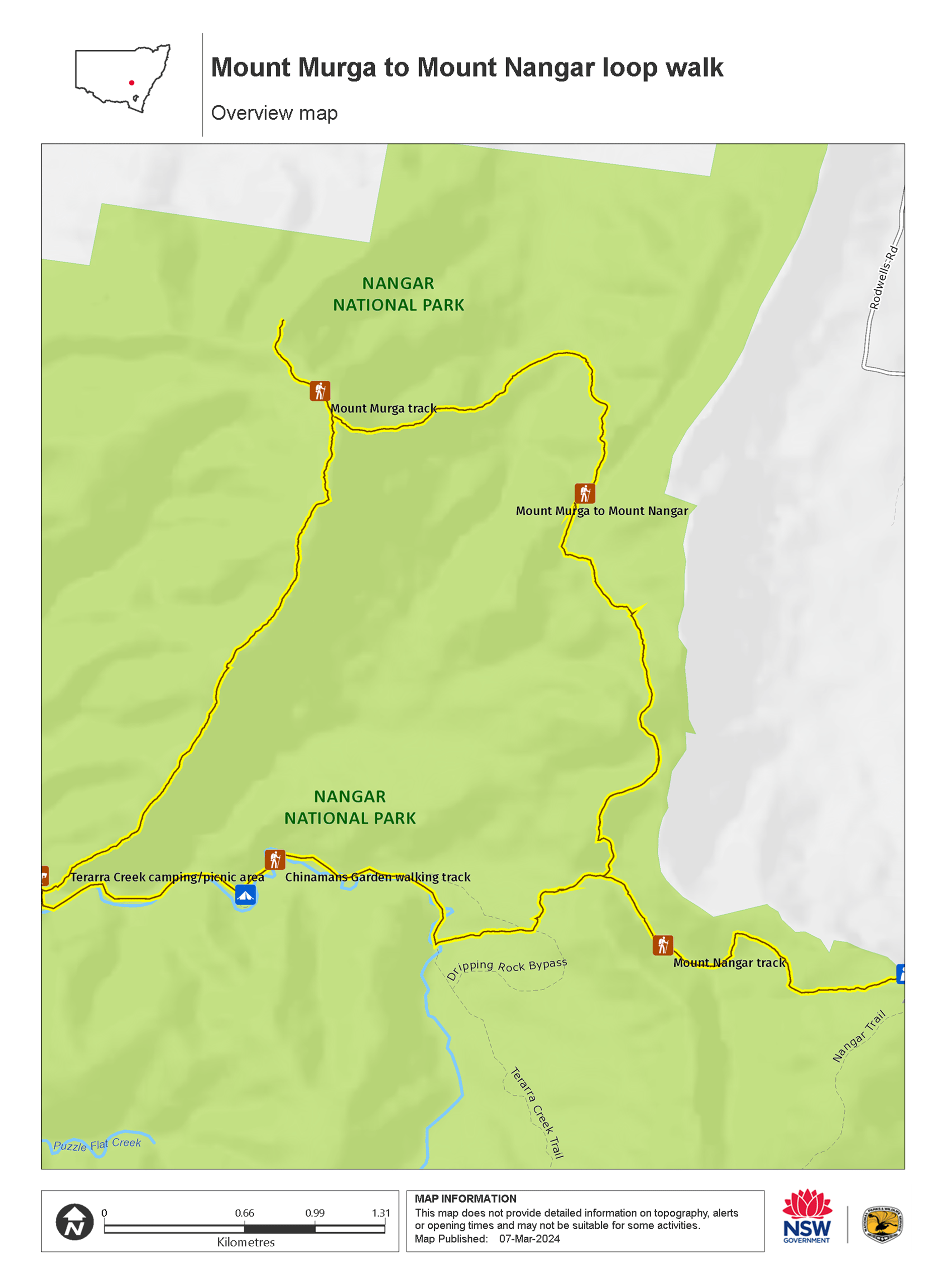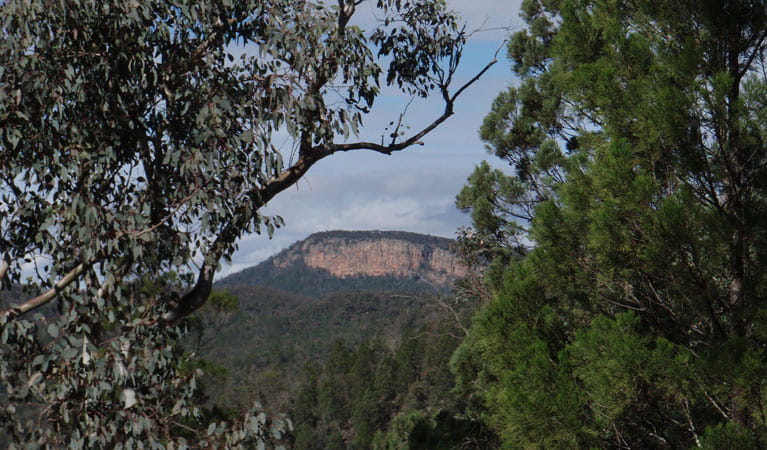Mount Murga to Mount Nangar loop walk
Nangar National Park
Overview
The Mount Murga to Mount Nangar loop walk combines some of the best hikes in Nangar National Park to give you a full day peak-to-peak experience.
- Where
- Nangar National Park in Country NSW
- Distance
- 16km loop
- Time suggested
- 7 - 9hrs
- Grade
- Grade 5
- Trip Intention Form
-
It's a good idea to let someone know where you're going. Fill in a trip intention form to send important details about your trip to your emergency contact.
- What to
bring - Drinking water, torch, hat, sunscreen, sturdy shoes, clothes for all weather conditions, snacks
- Please note
- This walking track is long and requires a moderate level of fitness.
- You’ll need to follow the white reflectors on tree trunks along Mount Murga walking track and Mount Murga to Nangar link track, and the yellow markers on Mount Nangar walking track.
- Remember to take a torch in case you’re still walking when the sun sets.
- There are kangaroo tracks that cross the walking track, don’t confuse these with the marked route.
- Summer is generally too hot for bushwalking in this park
If you’re looking for a hike in Nangar National Park, near Eugowra, you can’t beat this challenging walk which links the shorter Mount Murga and Mount Nangar walking tracks.
To complete the full loop, start at Terarra Creek camping and picnic area and travel along the fire trail for 1.2km until Mount Murga walking track. This follows the ridgeline through red stringybark and scribbly gum woodland. Once you’ve reached the top of Mount Murga you can take a 650m detour for stunning countryside views, or turn at the signpost onto the Mount Murga-Nangar link track.
Scramble down the steep hill and back up the eastern side, where you’ll meet Chinamans Garden walking track. This shortcut (3.3km) takes you back to the campground if you’re not feeling energetic enough to complete the full loop. Otherwise, continue 4.8km to Mount Nangar Lookout, past an intersection with photos of the colourful wildflowers you may see along the way.
Mount Nangar Lookout is a great spot to catch your breath and soak up the panoramic views across to Mount Canobolas. You might see birds of prey like the peregrine falcon, wedge-tailed eagle and brown falcon perching on the cliff face and circling over the open valleys.
Finish the loop by heading back down the Mount Nangar walking track to Dripping Rock and then walking 1.3km west along the fire trail to Terarra Creek camping and picnic area.
Also see
-

Terarra Creek camping and picnic area
Centrally located and naturally sheltered, Terarra Creek camping and picnic area makes the perfect base for bushwalking, mountain biking, camping and picnicking.
-

Chinamans Garden walking track
Chinamans Garden walking track is a moderate hike from Terarra Creek campground, in Nangar National Park, west of Orange. It’s easily linked with longer walks to stunning Mount Nangar or Mount Murga.
Map

Map legend

Local alerts
For the latest updates on fires, closures and other alerts in this area, see https://www.nationalparks.nsw.gov.au/things-to-do/walking-tracks/mount-murga-to-mount-nangar-loop-walk/local-alerts
General enquiries
- National Parks Contact Centre
- 7am to 7pm daily
- 1300 072 757 (13000 PARKS) for the cost of a local call within Australia excluding mobiles
- parks.info@environment.nsw.gov.au
Park info
- in Nangar National Park in the Country NSW region
- Nangar National Park is always open but may have to close at times due to extreme weather or fire danger.
Visitor info
All the practical information you need to know about Mount Murga to Mount Nangar loop walk.
Track grading
Features of this track
Distance
16km loop
Time
7 - 9hrs
Quality of markings
Sign posted
Experience required
Some bushwalking experience recommended
Gradient
Short steep hills
Steps
Occasional steps
Quality of path
Rough unformed track
Getting there and parking
Mount Murga to Mount Nangar loop walk is in Nangar National Park. To get to Terarra Creek campground and picnic area:
- Drive along The Escort Way, 10km from Eugowra or 70km from Orange.
- Turn right on Dripping Rock Road, where you’ll cross a cattle grid and enter the park.
- Continue along this road for 4.7km until you reach the carpark.
From Terarra Creek camping and picnic area it’s:
- 1.2km west along the fire trail to Mount Murga walking track
- 1.3km east along the fire trail to Dripping Rock day use area
- 11km east along the fire trail to Mount Nangar Lookout (4WD access only).
You can start and finish this walk at Terarra Creek camping and picnic area or you can do a car shuffle, with 1 car at the start of Mount Murga walking track and the other at Mount Nangar Lookout.
Road quality
Check the weather before you set out as roads and walking tracks may be closed following heavy rain.
The walking track beyond Dripping Rock day use area can only be used in dry weather. It may be closed to vehicles if the track has deteriorated. Check park alerts before you visit.
- Unsealed roads
- 2WD access to Dripping Rock day use area
- 4WD required to drive from Dripping Rock to Mount Nangar Lookout
- 4WD required in wet weather
Parking
- Parking is available at Terarra Creek camping and picnic area, Dripping Rock and Mount Nangar Lookout.
- Parking is limited at the start of Mount Murga walking track. There is only room for 2 cars opposite the trackhead.
Facilities
There are no facilties along this walk but you’ll find non-flush toilets at Terarra Creek camping and picnic area. Picnic tables are available at Mount Nangar Lookout, Dripping Rock and Terarra Creek campground and picnic area.
Water is not available, so make sure you bring plenty of drinking water for your stay.
Rubbish bins are not provided. Please take your rubbish with you when you leave.
Maps and downloads
Prohibited
Pets
Pets and domestic animals (other than certified assistance animals) are not permitted. Find out which regional parks allow dog walking and see the pets in parks policy for more information.
Smoking
NSW national parks are no smoking areas.
Learn more
Mount Murga to Mount Nangar loop walk is in Nangar National Park. Here are just some of the reasons why this park is special:
A refuge for wildlife

Amid the extensive farmlands of the central west, Nangar is home to many sedentary and migratory birds and local native animals. Among many bird species are several birds of prey such as the peregrine falcon, wedge-tailed eagle and brown falcon, which use the cliff face along the northern boundary for nesting and perching. The park is also home to the eastern grey kangaroo, common wallaroo, red-necked wallaby, swamp wallaby, little mastiff-bat and chocolate wattled bat. You may also spot the southern rainbow skink, eastern long-necked tortoise and spotted grass frog.
- Mount Murga walking track Enjoy scenic views, spring wildflowers, varied wildlife and birdwatching on Mount Murga walking track; great for a day of bushwalking near Orange and Forbes.
- Mount Nangar walking track Mount Nangar walking track to the lookout takes you bushwalking through varied landscapes to scenic views over Nangar National Park and surrounding farmlands in search of wildlife and wildflowers.
An ever-changing landscape

Ranging from the undulating hills in the south of the park to the long cliff line of red siltstone on the northern boundary - and the 770m-high Mount Nangar - the park offers a great variety of landscapes and views. Terarra Creek valley is open with wide creek flats and gentle slopes and the upper tributaries of Mogong Creek contains several natural springs. You'll see from the high vantage points of the park that the valley floor and more accessible lower slopes have been cleared by grazing and logging. Old growth forest is found in the steeper areas, but under national park protection, the park's vegetation communities will grow ever stronger.
- Mount Murga walking track Enjoy scenic views, spring wildflowers, varied wildlife and birdwatching on Mount Murga walking track; great for a day of bushwalking near Orange and Forbes.
- Mount Nangar walking track Mount Nangar walking track to the lookout takes you bushwalking through varied landscapes to scenic views over Nangar National Park and surrounding farmlands in search of wildlife and wildflowers.
Historic treasure

Gold was discovered around Eugowra in the 1860s, drawing miners and bushrangers, including the Gardener and Ben Hall gangs who roamed the area that the park now covers. Chinese miners lived here in the early 1900s, prospecting for copper. Historical remains in the park include remnants of gardens and orchards of Dripping Rock homestead, lost to fire in recent years, and its piggery, ruined hay shed and yards.
Wiradjuri country

A vast area of the central west of New South Wales, including Nangar National Park, is Wiradjuri country. Evidence suggests that Nangar Range has been an important landmark in Aboriginal culture and that the surrounding area was occupied for long periods. Places of significance include archaeological sites containing artefacts, stone scatters, quarries and scar trees.

